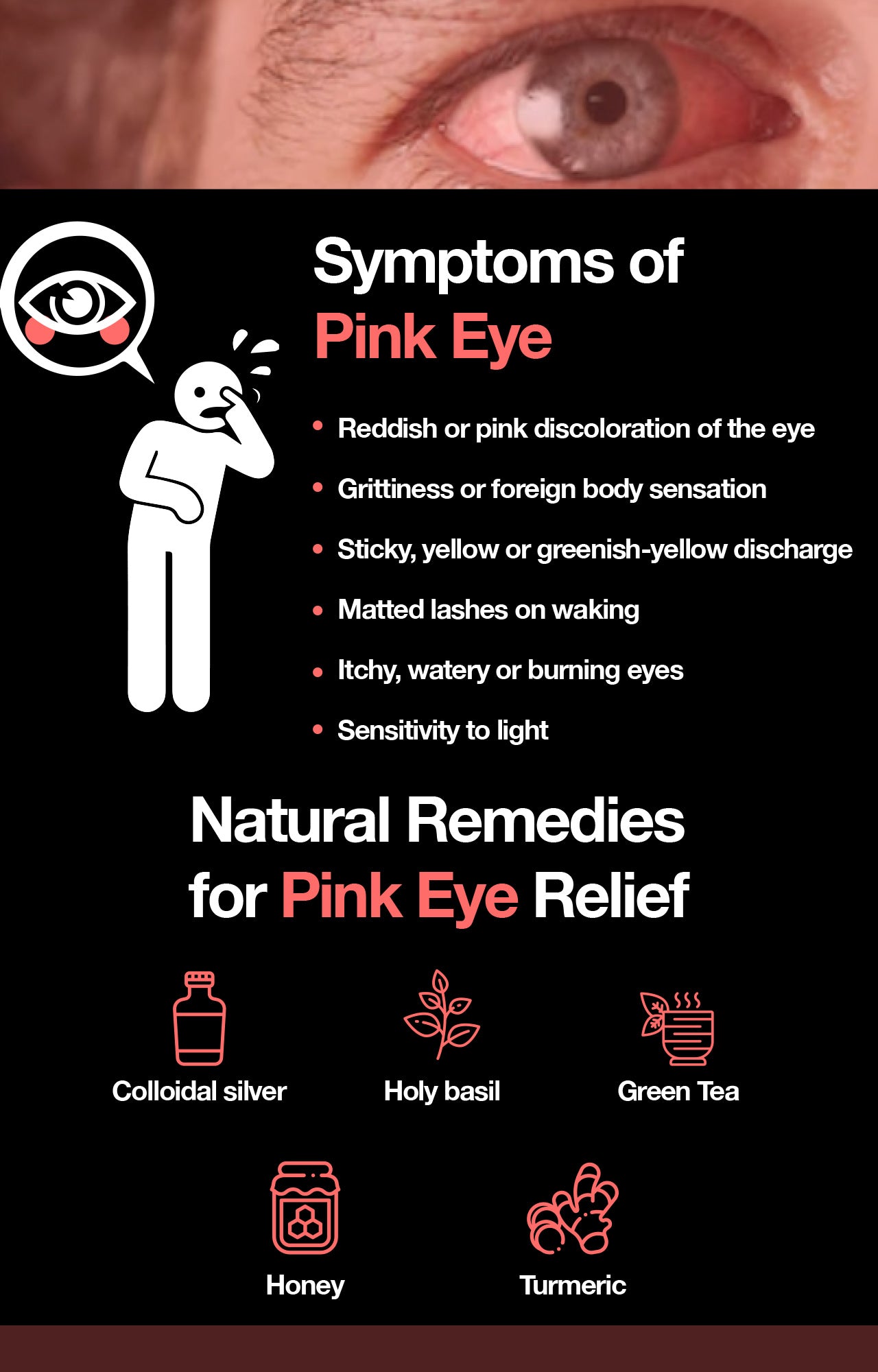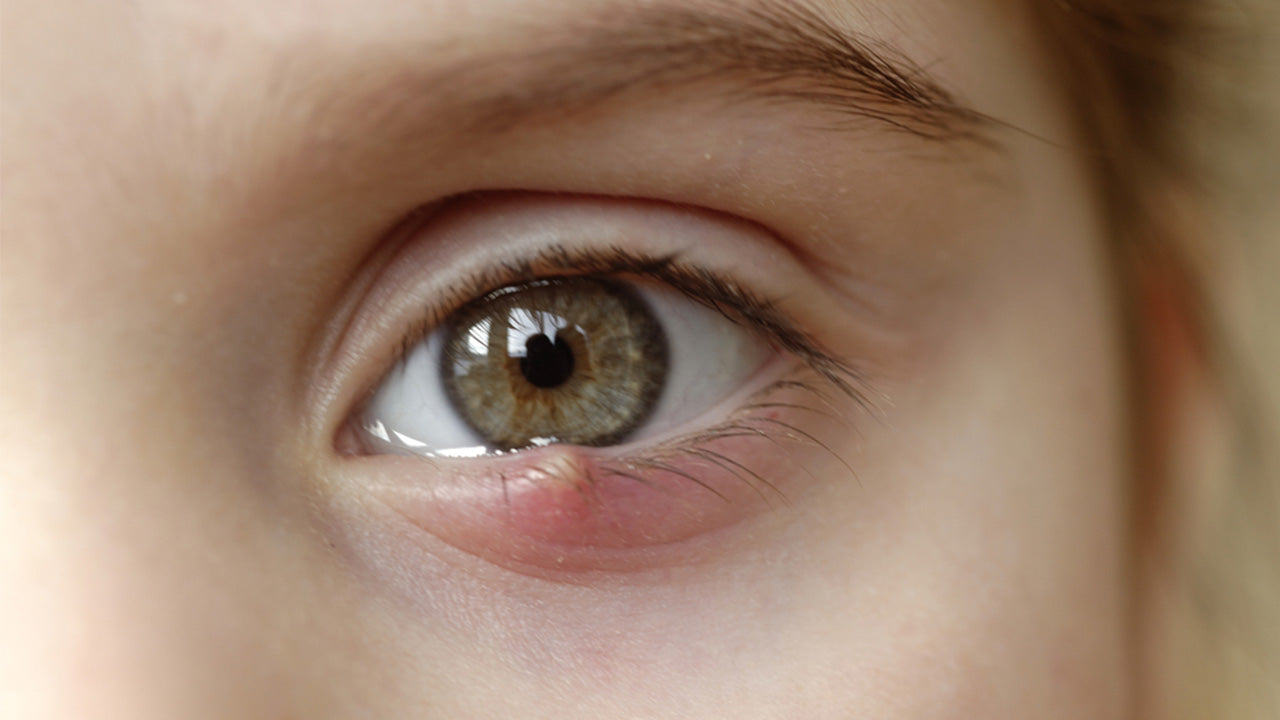Natural Remedies for Pink Eye Relief
 By: by Amino Science
By: by Amino Science

Pink eye, which is also known as conjunctivitis, is one of the most common eye conditions in both children and adults. Thankfully, it’s also very treatable. In fact, most cases clear up within a short period even without treatment. Despite this fact, this relatively mild illness still has the ability to strike fear in the hearts of babysitters and day care workers alike. With this in mind, come with us as we dispel the myths, uncover what really causes this common condition, and give you the information you need to find pink eye relief.
What Is Pink Eye?
As mentioned, pink eye is one of the most common conditions to affect the eyes. In fact, an estimated 3 million people are diagnosed with pink eye in the United States each year.
As the -itis in conjunctivitis indicates, pink eye is an inflammation of the conjunctiva, or mucous membrane that covers the front of the eye and lines the inside of the eyelid. The "pink" in pink eye actually refers to the inflammation of the small blood vessels in the conjunctiva. When these become inflamed, they’re more visible and cause your eye to appear reddish or pink.
What Causes Pink Eye?
Pink eye is usually caused by a viral or bacterial infection, but it can also be the result of exposure to irritants, such as contact lenses, air pollution, or cosmetics. Likewise, allergic conjunctivitis can be caused by a reaction to pollen, dust mites, or animal dander. And in rare cases, sexually transmitted infections like gonorrhea and chlamydia can be the cause.
Bacterial conjunctivitis may be the result of several different types of bacteria. However, the most common types that lead to an eye infection are:
- Staphylococcus aureus
- Haemophilus influenzae
- Streptococcus pneumoniae
- Pseudomonas aeruginosa
By contrast, viral conjunctivitis is usually the result of adenoviruses—the group of viruses that cause the common cold and upper respiratory infections (URIs).
Both bacterial pink eye and viral pink eye are highly contagious and are spread through contact with the fluid that drains from the eye of an infected person. Like viral conjunctivitis, bacterial pink eye can also occur alongside colds and URIs.
Risk Factors for Pink Eye
You may be at increased risk of developing pink eye if:
- You’re exposed to allergens or irritants.
- You’re exposed to someone who’s infected with the viral or bacterial form of the illness.
- You wear contact lenses, especially extended wear lenses.
Symptoms of Pink Eye
The symptom that distinguishes pink eye is, of course, the reddish or pink discoloration it causes in the whites of the eyes. People with pink eye may also experience a gritty sensation or swelling of the eyelids or feel like they have something in the eye. Symptoms may also depend on the type of conjunctivitis.
- Bacterial conjunctivitis: Symptoms include a sticky, yellow or greenish-yellow discharge in the corner of the eye that can sometimes cause the eyelids to stick together during sleep.
- Viral conjunctivitis: Symptoms include itchy, watery eyes and sensitivity to light.
- Allergic conjunctivitis: Symptoms include itchy, burning, watery eyes. Allergic pink eye is also often accompanied by a runny nose and congestion.
- Irritant conjunctivitis: Symptoms include watery eyes and mucus discharge.
Among the different types of pink eye, only allergic conjunctivitis always affects both eyes. Viral, bacterial, and irritant conjunctivitis may affect only one eye, though both can be involved as well.
Diagnosing Pink Eye
In most cases, your health care provider should be able to determine whether you have pink eye by simply speaking with you about your symptoms and medical history, while a physical exam may be all that’s needed to diagnose the cause of the illness. If necessary, your doctor may also collect a sample of discharge from the infected eye to help determine the type of pink eye and how best to treat it. Most of the time, however, people with pink eye don’t even require an office visit and can take care of symptoms at home.
Treating and Preventing Pink Eye
If you’ve been diagnosed with bacterial conjunctivitis, your health care provider may decide to treat it with antibiotic eye drops or ointment. Even though most cases are mild and go away on their own without intervention, people who have pus discharge, immune compromise, or certain types of bacteria generally need the extra support antibiotic treatment provides.
Regardless of whether your health care provider decides treatment is necessary, bacterial conjunctivitis usually improves in 3 to 5 days, though it may take 2 weeks before it’s completely gone.
Other forms of pink eye are typically treated with symptomatic management, though cases of viral conjunctivitis that have been caused by the herpes simplex virus may warrant treatment with antiviral medications.
Your health care provider may also recommend artificial tears, cleaning your eyelids with a cotton ball or wet cloth, and applying cold or warm compresses several times a day. Likewise, people with allergic conjunctivitis may require allergy medication.
Additionally, people with contagious forms of pink eye should take steps to help prevent the spread of the infection:
- Avoid contact lenses until the illness has cleared.
- Throw away any contact lenses or eye cosmetics that might be contaminated.
- Don’t share eye makeup, towels, washcloths, or personal care items.
- Change pillowcases regularly.
- Don’t touch or rub your eyes.
Natural Home Remedies for Pink Eye Relief
When you have pink eye, you may think your treatment options are limited. But, happily, you’d be wrong. There are actually a number of natural remedies out there that can help with symptom relief and even eliminate the infection altogether.
Colloidal Silver
Perhaps the most amazing pink eye treatment is colloidal silver. Unlike prescription antibiotics, which target only certain types of bacteria and may be ineffective against resistant strains, colloidal silver is an equal opportunity antimicrobial and doesn’t lead to resistance. Moreover, one or two drops in the affected eye may be all it takes to wipe out a pink eye infection.
However, not all colloidal silvers are created equal. Some can’t be put in the eye and may even cause argyria—a condition that causes the skin to turn blue-gray. So always look for true colloidal silver before treating pink eye, or any other infection.
Holy Basil
Holy basil, or tulsi, as it’s also known, possesses antiviral, antibacterial, and anti-fungal properties that make it one of the best natural treatments for pink eye. To use holy basil as a pink eye treatment, first steep the leaves in boiled water for 10 minutes, and then use the water as an eyewash. You can also dip a washcloth in the solution and apply as a warm compress.
Green Tea
The bioflavonoids in green tea not only fight bacteria and viruses but are also helpful in reducing the irritation and inflammation that come with pink eye. Try steeping a green tea bag in boiled water, cooling it, and placing it on the infected eye, or brew a cup of green tea and use it with a washcloth as a warm compress.
Turmeric
Many are familiar with turmeric as the main spice in curry, but this powerful herb is also antiseptic, anti-inflammatory, and antibacterial. To use turmeric to help treat pink eye, add 2 tablespoons of turmeric powder to 1 cup of boiled water, soak a washcloth in the solution, and use it as a warm compress.
Honey
Most people’s minds probably wouldn’t naturally run to honey as a treatment for pink eye, but it actually has a long history of use in eye ailments. And its benefits have even been backed by science, with research demonstrating that honey is effective in reducing the redness, swelling, pus discharge, and length of bacterial conjunctivitis infections.
While recommendations for the perfect honey treatment differ—and appear to be greatly dependent on personal preference and severity of infection—two of the most popular are:
- A tablespoon of raw honey in 2 cups of purified or boiled water for use as an eyewash
- A bit of raw honey smeared across the lashes of the closed eye
If you or someone you love is going through a bout of pink eye, the good news is that most cases are quite mild and go away on their own. However, if you’re experiencing eye pain, intense eye redness, sensitivity to light, blurred vision, or symptoms that don’t improve, or if you have a weakened immune system, don’t hesitate to see your health care provider right away. And don't forget: you can give your immune system a boost with essential amino acid support!


Up to 25% off Amino
Shop NowTAGS: conditions natural cures
Join the Community
Comments (0)
Most Craveable Recipes




 833-264-6620
833-264-6620



















